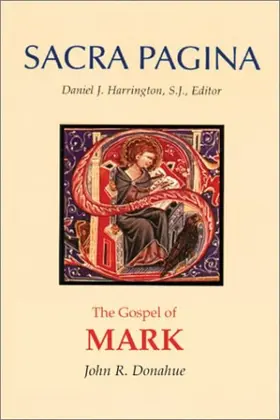

The Gospel of Mark
in Sacra Pagina
Pages
496 pages
Publisher
Liturgical Press
Published
2002
ISBN-13
9780814658048
Collections
This book appears in the following featured collections.
- New Testament Commentaries & Monographs by Princeton Theological Seminary
- Commentaries by Roman Catholic Scholars by John Dyer
Reviews
An outstanding, succinct, semi-technical commentary, focused on interpretation of the text itself, though still sensitive to historical and intertextual elements. Though Catholic in perspective, this commentary series is certainly worthwhile for a much broader audience.
Focuses on intratextual (reading Mark as Mark, rather than with reference to its prehistory) and intertextual (how the text of Mark draws on other texts, especially the OT, to interpret the person and mission of Jesus) forms of analysis.
[Full Review]
Sacra Pagina is a series of commentaries by an international team of Catholic scholars on New Testament books and is intended for a broad audience, ranging from �biblical professionals� to religious educators. The purpos e of the series is �to provide a critical analysis [of New Testament texts] without any loss of sensitivity to religious meaning.� This volume on the Gospel of Mark, while it might have been organized in a more helpful way, is largely successful in fulfilling its purpose for its intended audience. The authors, both long-time scholars of Mark, begin by noting that their commentary will be �intratextual� and �intertext ual.� In practice, �intertextua l� means that the authors pay attention to the relationship between Mark and the Old Testament, noting to a lesser extent the ways early Jewish literature and archaeology impinge upon Mark�s text. In a mildly confusing fashion, the authors write that for them �intratextual� means that they want to interpret �Mark as Ma rk by Mark.� This appears to mean that they pay attention to the story Mark tells, as well as to particular Markan themes, according to the practice of formalist narrative criticism. While the authors create the impression that this dual commitment to intratextuality and intertextuality will result in a different sort of reading from that found in other commentaries, what readers of the book actually get is a straightforwardly historical-critical commentary on Mark by two scholars who know the scholarly literature well, love the Gospel of Mark, and are committed to the church.
[Full Review]
One of several new commentaries on Mark to hit the shelves recently, this book by respected scholars Donahue and Harrington intends to highlight Mark�s literar y and theological traits. Ultimately, the authors produce a thoroughly informative but fairly conventional reading of Mark�s n arrative. Donahue and Harrington begin with a statement of their interpretive approach (more on that below), followed by a lengthy overview of methodological developments in biblical studies from the late nineteenth century to the present, with particular attention to Markan scholarship (2�22). Surprisingly, the authors offer little discussion of their major theoretical terms intertextuality and intratextuality, nor do they mention the usual suspects associated with theories of intertextuality (Kristeva; Barthes; Derrida). The introduction takes up familiar themes in Markan scholarship�genre, Sitz im Leben, Christology, discipleship, and eschatology�but also discusses Ma rk�s use of the Old Testament and relationship to Judaism (34�37) as well as noting similarities between Mark�s Gospel and Pauline letters (38�41). In a nod to church tradition, the authors situate Mark�s community in Rome, while acknowledging and critiquing recent studies that locate Mark in Galilee or Syria (41�46).
[Full Review]
The biblical commentary, as it evolved in the twentieth century, was largely a historical-critical enterprise. The major methodological approaches employed (e.g., Religionsgeschichte, text criticism, source criticism, form criticism, redaction criticism) variously analyzed the historical influences and stages through which the text had passed to reach its final form. Increasingly detailed studies plumbed the vertical dimensions of the text. Some, such as Joseph Fitzmyer�s Commentary on Romans (Anchor, 1993), included the history of interpretation of selected pericopes in their purview, and increasingly social-scientific criticism was blended into the mix. Yet the concerns of the new literary criticism that began to be articulated in New Testament studies in the late 1970s, picking up increasing mass and momentum in the 1980s and 1990s, made little impact upon the genre. In commentaries on the Gospels, the narrative dimensions of the received text (e.g., its story, plot, characterization) were simply not a primary locus of interpretive interest. The appearance of Donahue and Harrington�s Mark commentary in the Sacra Pagina series signals a significant change in this regard.
[Full Review]



